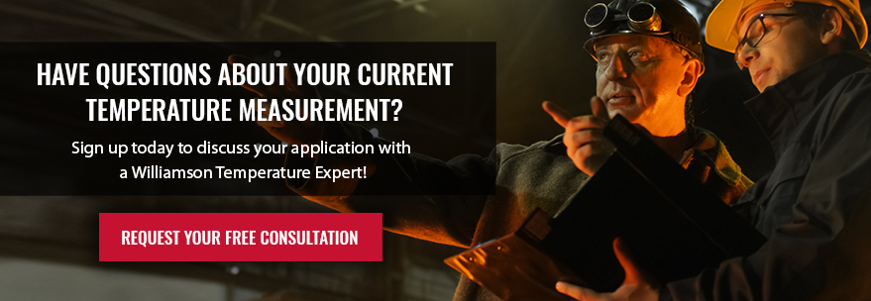1. What is the Target Material?
Knowing the measured target material can help us determine the type of technology that would be needed. For applications measuring paper or textiles for example, we know we are looking at a non-reflective, high-emissivity material and can use a general purpose long-wavelength sensor. For a good majority of steel applications, we recommend using a ratio pyrometer to deal with emissivity variation and scale. For more unique and challenging materials like aluminum and copper, we know that a multi-wavelength is needed for the application.
2. What is the Temperature Range of Interest?
This seems like a pretty standard question to ask when dealing with a temperature measurement application. This also relates to the wavelength that we use. A good general rule of thumb is that the longer wavelength, the lower temperatures you can measure. Conversely, the shorter the wavelength, the higher the temperature you can measure. Another point to note is that short-wavelength pyrometers will produce less of an error than long-wavelength pyrometers. This is especially true at high temperatures.
3. Are There Any Optical Obstructions (Water, Steam, Scale, Flames, Combustion Gasses, Plasma, Physical Obstructions)?
This is probably one of the most important questions that we ask. Why? Because with the right wavelength selection, we can actually view through these different types of interferences to get an accurate measurement of the target material. Not all wavelengths and products can view through every single optical obstruction. That is why it is also important to list any and all obstructions which will let us know the exact type of conditions you are dealing with and will better allow us to determine which wavelength is needed for your specific application. For example, we have two different products, one designed to measure the temperature of a flame and one designed to view through flames. The only difference between the two models is the wavelength.
4. What is the Method of Heating (Induction, Flames, Gas Furnace, Vacuum Furnace)?
If you are heating an object with a flame or inside a furnace where there are combustion gasses, we can select a pyrometer with a wavelength that views through those flames and combustion gasses. If you are doing an induction heating application, we might recommend using a fiber-optic model to view through the induction heating coils. If measuring inside a vacuum furnace, are there any plasmas being created we would need to look through (nitrogen or argon for example)? Again, by choosing the correct wavelength you can view through different plasmas.
5. What is the Size of the Target?
This question will help us determine the optical resolution of the pyrometer. For single-wavelength applications, we want to make sure that we are getting a full field-of-view. For some other applications, like a wire measurement, it can actually determine which technology we will use. If it is a small target we are measuring, we would recommend using a ratio pyrometer which is heavily weighted to the hottest temperature it sees in the field-of-view. Moreover, using a ratio pyrometer with a large field of view allows you to tolerate misalignment. Ratio pyrometers are perfect for small and/or wandering targets, or in case the pyrometer accidentally gets bumped out of its original alignment.
6. What is the Distance from the Pyrometer to the Target?
This, in conjunction with the size of the target will help determine the optical resolution of the pyrometer and as previously mentioned might even determine the technology. For some applications, physical constraints will not allow for a pyrometer to be mounted close to the process, and it might need to be mounted 20ft away. If there are other optical barriers in the way, such as scaffolding, machinery, etc., we would want to make sure our optics are tightly configured so that they avoid these physical obstructions. Similarly, you might want to consider using a fiber optic configuration to fit into tight or hard to reach locations.
So with those simple 6 questions we can really whittle down which pyrometer technology is appropriate for your application. We like to think that there is a specific pyrometer for every application, not that there are a select number of pyrometers that can be applied to every application.

